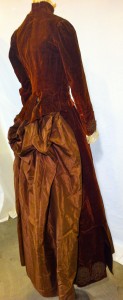The late 19th century and early 20th century represented a time of innovation and great change for the United States. As the nation expanded from the East to the West, those moving westward experienced a completely new way of life. Women faced the most significant changes upon arriving in the west. Once adapted to the new environment, women learned to deal with the extra responsibilities on the frontier. Due to the vast distances between each property and the low female population, women encountered forced isolation. Subsequently this influenced an innovation in the arts and crafts movement.
The technological advancements made during the Industrial Revolution redefined dressmaking on both a large and small scale. Mass production became possible, allowing women to work, and even purchase clothing traditionally only worn by wealthier women10. According to the National Museum of American History, “as a fixture in domestic life, (the sewing machine) obviously improved the housewife’s chances of adequately clothing her family11.” Not only was it possible to produce clothing in a timely manner, but also patterns and advertisements included in magazines provided western women with the latest fashions around the world12. For most women in the west the sewing machine brought a new world of craft. Clothing began showing more expressive and creative qualities, which brightened up the plain drab clothing worn by most ladies of lower classes. Over time fashions of the East coast and even European influences made their way to the West. As the century progressed wedding traditions changed, as most American cultures began adopting the use of a white wedding dress. Prior to that time however, “homemade, made-over and second-hand clothing comprised the greater part of most early 19th century women’s wardrobes13.” Women commonly re-used their dresses, sprucing them up for special occasions and passing them down to future generations. This iridescent silk pagoda wedding dress, used for years, likely by several women, is a great example of a machine-sewn garment, hemmed over the years to accommodate its wearers.
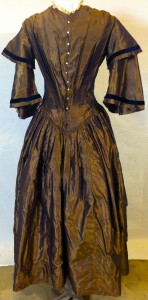
Notice the velvet horizontal stripes on the sleeves as well as the lace detail on the collar. Also, the dress has tiny pleats on the bodice and mother-of-pearl buttons. Image courtesy of Idaho State Historical Society. Catalog # 1988.81.1

Pay attention to the pagoda style sleeve, a very popular Victorian fashion trend. Image courtesy of Idaho State Historical Society. Catalog # 1988.81.1
The fabric used is iridescent gray-purple silk and has blue velvet lacing around the layered pagoda sleeves. There is a lot of visible stitching which suggests the dress had many years of use either by the same women over several years or handed down to younger generations. The sleeves and collar have laced trim. The fabric flows from the shoulders and into a bell like skirt. The waistline was tightened with riveted stitch work. The violet dress shows qualities of alteration for its user; on the back an extension was added to accommodate either a growing girl, or a larger woman.
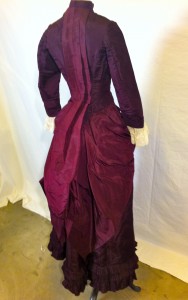
Notice the additional fabric panel in the center of the posterior bodice, added to the dress at a later date. Image courtesy of Idaho State Historical Society. Catalog # 1975.25.2/1-2
Homemade dresses following the release of the sewing machine came adorned with intricate beadwork, ruffling, buttons, and lacework. This dress, worn for a wedding in the late 19th is a prime example of a dress made with a sewing machine.

A classic example of a 19th century dress crafted using a sewing machine. Image courtesy of Idaho State Historical Society. Catalog # 935 C
The dress and coat material is made with a brown velvet fabric and tan iridescent silk fabric. It includes flower trim detailing made from twisted rope on the elbows and right above the waistline. Originally metallic gold, this dress’s luminescence has tarnished over time. The dress includes a built in bustle and jacket. The jacket has lacing along the collar and wrist cuffs; it too has discolored over time. The dress appears to be made with a sewing machine, but hand stitch hems are present.
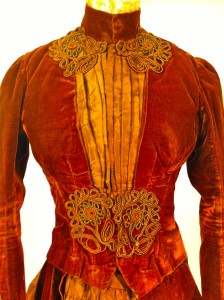
Notice the velveteen fabric with underlying silk pleats. The detail of this dress suggests that it was crafted using a sewing machine. Image courtesy of Idaho State Historical Society. Catalog # 935 C
Aside from refining clothing production on a major scale, the sewing machines presence influenced the dress reform of the late 19th century. Women in the West lived in a hotter and dryer climate; wearing heavy thick-layered dresses over tightly laced corsets quickly became tiresome. In protest to the uncomfortable clothing, women everywhere began altering their dress to better suit them. Lucy Stone expressed her opinion on dress and its influence on women’s equality, “ when she is so, and takes her place, clothed with the dignity which the possession and exercise of her natural human rights give, she will be able, unquestioned, to dictate the style of her dress14.” The new confidence inherited from the dress reform helped motivate women to seek further equality among men.
In the early 20th century Cecil Gladys Hall married Wesley Cooper in Oakley, Idaho. Like most women living on the western frontier, Hall had a large load of responsibilities, both at home and in public. This sewing machine made in 1901, and handed down to Hall from her mother, made providing clothing for her family much easier.
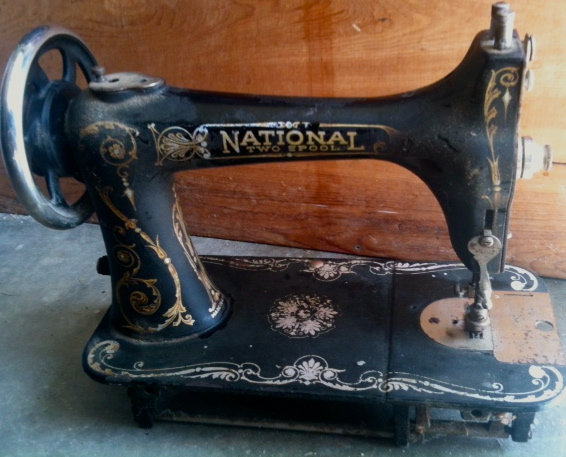
During the late 19th century women used sewing machines similar to this one. Image courtesy of author's collection.
ENDNOTES
10. Fernandez, Nancy Page. “Innovations for Home Dressmaking and the Popularization of Stylish Dress”. Journal of American Culture. Accessed April 4, 2012) http://onlinelibrary.wiley.com/doi/10.1111/j.1542-734X.1994.t01-00023.x/abstract
11. Fernandez. “Innovations for Home Dressmaking and the Popularization of Stylish Dress.”
12. Fernandez. “Innovations for Home Dressmaking and the Popularization of Stylish Dress.”
13. Fernandez. “Innovations for Home Dressmaking and the Popularization of Stylish Dress.”
14. Fernandez. “Innovations for Home Dressmaking and the Popularization of Stylish Dress.”

